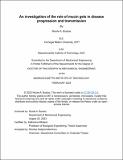An investigation of the role of mucin gels in disease progression and transmission
Author(s)
Bustos, Nicole A.
DownloadThesis PDF (3.366Mb)
Advisor
Ribbeck, Katharina
Wagner, Caroline
Terms of use
Metadata
Show full item recordAbstract
Mucus is a biological hydrogel that coats every wet epithelial surface of the body, including the respiratory tract. Within the body, mucus serves as a barrier: a mesh network made of mucin polymers that act as a size and biochemical filter, trapping small molecules, including pathogens. When mucus is cleared from the respiratory tract via exhalations such as coughing or sneezing, it can act as a vessel for infectious material from infected individuals that can be carried to other potential hosts or remain in the environment. The high shear rates associated with violent exhalations cause respiratory mucus to fragment into droplets spanning a range of sizes. Once emitted, droplets are propelled to nearby surfaces or entrained and advected in ambient air flows. Larger droplets may settle quickly to the ground, whereas smaller aerosolized droplets may remain suspended in the air and evaporate over time.
In this thesis, we investigate the role of mucins in these within-host and external disease processes. In mucosal layers within the host, mucus plays an important role in limiting the progression of infectious pathogens. The pathogen’s ability to penetrate mucus, in many cases, determines its ability to reach its target cell and initiate infection before being cleared by the body. We begin by studying the impact of mucins on the transport of virus-sized particles. First, we examine the transport of bacteriophage, a model system for viruses, and nanoparticles of comparable size in reconstituted mucin gels simulating the respiratory tract and intestinal environment. Our findings reveal that phage have different transport abilities tied to their geometry, size, and surface chemistry. In addition, they are relatively unhindered in concentrated mucin gels compared to similar-sized nanoparticles. We show that in different phage populations, diffusive Brownian motion is associated with both Gaussian (normally distributed) and non-Gaussian population-level and particle-level step size distributions, which consequently impacts the spread and confinement of these particles in mucin gels. Moreover, we establish that the degree of Gaussianity is influenced by mucin type, suggesting that mucin-phage biochemical interactions play a significant role in phages’ mucin specific transport, as opposed to differences in the mucin network structure.
Next, we study the effect of mucins and nanoparticles on the fragmentation dynamics of biological fluids. Polymers are known to shift and broaden the droplet size distributions of complex fluids compared to their Newtonian counterparts. Yet, the impact of mucus’ main solid component, mucin, along with pathogens, on the size and dispersal of emitted droplets remains incompletely unresolved. We use varying concentrations of charged nanoparticles to simulate pathogen load in several mucus polymer model systems. This highlights the importance of incorporating native mucin properties and mucin-pathogen interactions in the modeling of biological fragmentation processes. Our measurements show that the shear rheology of mucin gels are insensitive to the presence of particle load. On the other hand, the extensional rheological properties of mucin gels, including the characteristic relaxation time and thread lifetime, were greatly modified by suspensions of nanoparticles. Accordingly, the average droplet size of sprayed mucin gels is increased and the spatial distribution (depth and clustering) of droplets was shown to vary depending on particle charge. By comparison, other mucus polymer models did not recapitulate the same behaviors.
The findings of this thesis underscore the importance of pathogen-mucin dynamics across multiple length scales. Integrating mucosal barriers into experimental systems is crucial for understanding the mechanistic and biophysical principles underlying disease transmission and initial host infection.
Date issued
2024-02Department
Massachusetts Institute of Technology. Department of Mechanical EngineeringPublisher
Massachusetts Institute of Technology